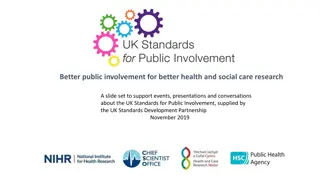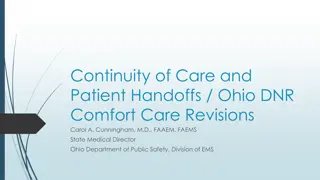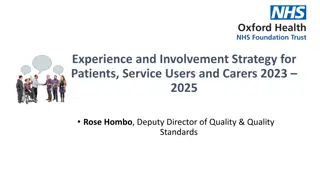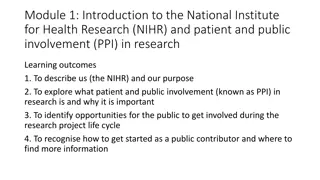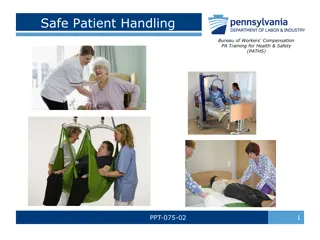Understanding Public and Patient Involvement (PPI) in Research
Public and Patient Involvement (PPI) in research emphasizes active participation of the public and patients in various research activities such as defining research questions, steering research projects, and engaging with research outcomes. It differentiates involvement, participation, and engagement, stressing the importance of precise language use for true understanding. PPI involves a diverse range of participants and stakeholders, highlighting the need for inclusive and person-centered approaches.
Download Presentation

Please find below an Image/Link to download the presentation.
The content on the website is provided AS IS for your information and personal use only. It may not be sold, licensed, or shared on other websites without obtaining consent from the author. Download presentation by click this link. If you encounter any issues during the download, it is possible that the publisher has removed the file from their server.
E N D
Presentation Transcript
An Introduction to Public and Patient Involvement (PPI) in Research Dr Lucy Whiston Programme Manager PPI Ignite Network at DCU Research Fellow Dublin City University All Ireland Institute of Hospice and Palliative Care, 9thOct. 2023
What is PPI? PPI is research being carried out with or by members of the public rather than to , about or for them (1). Who Those whom the research will impact or affect. What Engagement X Participation X Involvement
Defining research question Research conception, design & implementati on Working with funders to review applications PPI is . public and patients as active partners Disseminati ng research outcomes Proofing documents, leaflets & articles Data Research project steering group analysis & identifying key findings Interviewing research participants
Participants in research project/clinical trial PPI is not public and patients as data providers Providing opinions in focus groups/seminars/ conferences etc. Donating sample materials for research Answering questionnaires
Language Public and Patients (2-4) Patients Consumers Service users Customers People People living with Lay people Public Members of the general public Citizens Experts by experience Lay stakeholders Advocates PPI contributors Patient organisations Support groups Charities for people with Family members Carers Caregivers Research Partners No one-fits-all solution, start by asking what language the person would prefer
Terminology - Involvement Involvement: where people are actively involved in designing and conducting research projects and research organisations Participation: where people take part in a research study as a research participant Engagement: where information and knowledge about research is shared with the public i.e., providing and disseminating research knowledge to people *Different acronyms and different terms are used interchangeably - what need to do is ensure PPI activities equate to true understanding of involvement, not participation or engagement - use language precisely as it varies internationally
Why is PPI in research important? Democratic principles Improve research quality (5-9) Research and funding body support (7) National and international policy
Benefits (10) Benefits Patient Partners Emotional - living with purpose, sense of achievement through meaningful contributions, expressing emotions in safe environment Research System Practical - co-generation of data Psychological - sense of self, self-confidence, mental health, inspiration and motivation Healthcare System Involvement as opportunity to improve services Cognitive - learning opportunities, positive space for enriching discussions; appropriate training Social - building and sustaining relationships, enhanced self-confidence, sense of belonging, ability to contribute to research
PPI Ignite Network: Values and Principles (14) Values and Principles Framework (2022) (15) NIHR CED, formerly NIHR INVOLVE 1 Respect 2 Support Transparency 3 4 Responsiveness 5 Diversity 6 Accountability
What is important for successful public involvement in palliative care research? (16) Based on a qualitative review of PPI in palliative care research. 7 public members and 19 researchers
References 1. INVOLVE. Briefing notes for researchers: involving the public in NHS, public health and social care research [Internet]. Eastleigh: INVOLVE; 2012 [cited 2018 Jun 22]. Available from: http://www.invo.org.uk/wp- content/uploads/2014/11/9938_INVOLVE_Briefing_Notes_WEB.pdf 2. Kennan A. The language of patient and public involvement and how not to mess it up [Internet]. MRCG Blog. 2018 [cited 2018 May 11]. Available from: https://www.mrcg.ie/go/news/mrcg_blog 3. Morley R, Chapman S. What s in a name? Patients, people and the power of words [Internet]. Evidently Cochrane. 2017 [cited 2018 May 11]. Available from: http://www.evidentlycochrane.net/patients-people-power-of-words/ 4. Staley K, Elliott J, Stewart D, Wilson R. Who should I involve in my research and why? Patients, carers or the public? Research Involvement and Engagement. 2021;7(1):1 8. 5. Vale CL, Thompson LC, Murphy C, Forcat S, Hanley B. Involvement of consumers in studies run by the Medical Research Council Clinical Trials Unit: Results of a survey. Trials [Internet]. 2012 Jan 13;13(1):9. Available from: https://doi.org/10.1186/1745-6215-13-9 6. Ashcroft J, Wykes T, Taylor J, Crowther A, Szmukler G. Impact on the individual: what do patients and carers gain, lose and expect from being involved in research? Journal of Mental Health. 2015;1 8. 7. Domecq JP, Prutsky G, Elraiyah T, Wang Z, Nabhan M, Shippee N, et al. Patient engagement in research: a systematic review. BMC health services research. 2014;14(1):89. 8. Brett J, Staniszewska S, Mockford C, Herron Marx S, Hughes J, Tysall C, et al. Mapping the impact of patient and public involvement on health and social care research: a systematic review. Health Expectations. 2012;
References 9. Health Research Board. Results of the Public and Patient Involvement Survey: How would you support public and patient involvement in research? [Internet]. Dublin, Ireland: Health Research Board; 2017. Available from: http://www.hrb.ie/fileadmin/Staging/Documents/RSF/Grant_Management_Nov_2015_onwards/2Pre_award__Grant_call_docum ents_/2016_grant_calls/Public_and_Patient_Involvement/HRB_PPI_survey_results.pdf 10. Paolucci A, Nielssen I, Tang KL, Sinnarajah A, Simon JE, Santana MJ. The impacts of partnering with cancer patients in palliative care research: a systematic review and meta-synthesis. Palliat Care Soc Pract. 2022 Oct 18;16:26323524221131581. doi: 10.1177/26323524221131581. Erratum in: Palliat Care Soc Pract. 2023 Jul 6;17:26323524231185693. PMID: 36274787; PMCID: PMC9583219. 11. Greenhalgh et al. (2019) Frameworks for supporting patient and public involvement in research: Systematic review and co design pilot. Health Expectations. 22:785-801. 12. Bowman S, Morris K, Adshead M. A How To Guide: A Framework for Engaged Research- Society and higher education addressing grand societal challenges together [Internet]. Dublin, Ireland: Campus Engage, Irish Universities Association and Irish Research Council; 2018 [cited 2018 Jan 6]. Available from: http://www.campusengage.ie/sites/default/files/resources/Framework%20for%20Engaged%20Research%20Web.pdf 13. International Association for Public Participation (IAP2) (2014) IAP2 s Public Participation Spectrum [www.iap2.org] 14. INVOLVE. Public Involvement in Research: Values and Principles Framework. INVOLVE Eastleigh; 2015. 15. PPI Ignite Network Values and Principles Framework, 2022 Trinity PPI Ignite Office 16. Johnson et al. (2021) Patient and public involvement in palliative care research: What works, and why? A qualitative evaluation. Palliative Medicine. 35 (1): 151-160.









